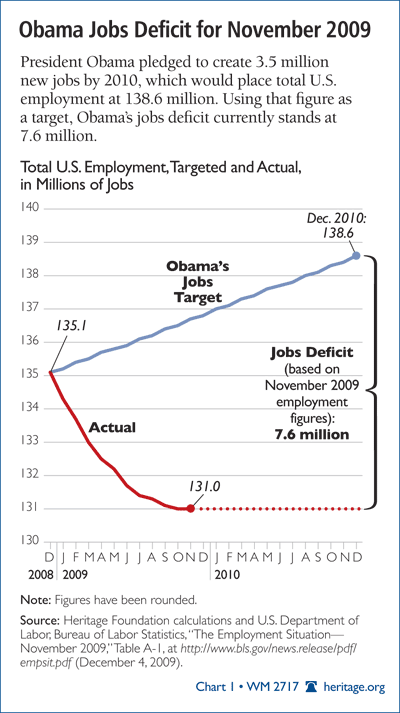Another month under President Obama, another 11,000 jobs lost, pushing the total Obama jobs deficit to 7.6 million. One day after the White House jobs summit admitted that the President’s policies—including the massive $787 billion stimulus enacted last spring—are not working to create jobs, the Department of Labor’s monthly jobs report added the exclamation point.
Barack Obama promised that if elected he would create 3.5 million jobs by the end of 2010 through new economic policies, beginning with the enactment of a massive economic stimulus package. So far in his term in office, employment has dropped by about 3.3 million jobs, while the unemployment rate remains at 10 percent.[1] Accompanying his jobs promise, the President also emphasized accountability and measuring his presidency by results. The President’s jobs promise means total employment should be at least 138.6 million by 2010.
Fortunately, the economy’s natural recuperative powers, spurred by powerful, effective intervention from the Federal Reserve, mean that the recession may be ending in the sense that overall output and incomes are stabilizing and sustained growth may resume. Even so, job losses are likely to continue for months, and a very high unemployment rate could persist for years. By his own standard, the Obama jobs deficit attests that his policies have so far failed and show no sign of succeeding. A fundamental course correction is required.
Promises, Promises, and the Growing Jobs Deficit
President Obama’s oft-repeated promise to create 3.5 million jobs demonstrates that this was a serious campaign promise, and the figure itself was apparently chosen with care. The original target set in the fall of 2008 was 2.5 million jobs, but as employment fell at the end of 2008, he increased the employment target by 1 million to 3.5 million.
When Obama made his 3.5 million jobs promise, employment stood at about 135.1 million according to the Department of Labor’s most commonly used measure. This establishes the Obama jobs target for December 2010 at 138.6 million. It also establishes a basic trajectory for employment the economy would need to approximate to hit that target.
According to the latest jobs report, total U.S. employment fell to 131 million in November. Projecting the jobs promise over the period and comparing the result with the current employment level yields a running Obama jobs deficit of about 5.7 million. In other words, the President is now almost 6 million jobs behind schedule. The cumulative Obama jobs deficit—the difference between the end target and the current employment level—stands at 7.6 million.[2]

Mathematically, closing the Obama jobs gap would require monthly growth in employment of 583,000 over the 13 months between the start of December 2009 and the end of December 2010. The greatest 13-month average increase in employment in modern American history (401,000) occurred during the peak of the Reagan boom in the 13 months concluding September 1984, dwarfing even the strongest similar period of job growth during the Clinton Administration.[3] Closing the Obama jobs deficit would require significantly faster monthly job growth than ever before.
However, the Obama jobs promise can still be kept because the workforce and the economy are much larger today than they were in 1984. This means that the job growth relative to the size of the workforce can be less than that experienced under Reagan and yet still close the Obama jobs deficit. It also highlights the remarkable force of the Reagan recovery driven by spending restraint, tax cuts, support for free trade, and less regulation. But it also underscores that if President Obama pursues similar economic growth policies, he could conceivably close his jobs deficit and make good on his promise.
Why Has the Stimulus Failed?
The centerpiece of Obama’s short-term stimulus program is a massive $787 billion fiscal program he signed into law last spring. By all accounts, this legislation was poorly crafted. However, poorly crafted or not, as short-term economic stimulus it was doomed from the outset as it is based on the erroneous assumption that deficit spending can increase total demand in a slack economy.
This theory of demand manipulation ignores the simplest of realities: Government spending must be financed. So to finance the resulting deficit spending, government must borrow from private markets, thereby reducing private demand by the same amount as deficit spending increases public demand.[4]
The Congressional Budget Office (CBO) recently released a shameful analysis reporting that the spending stimulus worked.[5] It is important to understand the nature of this analysis. The CBO used mathematical economic models that build in the assumption that deficit spending is stimulative. They then ran the models showing how the economy would have performed without the stimulus and, lo and behold, the models showed the stimulus increased output and jobs. The fact is that CBO’s analysis did not assess the effectiveness of the stimulus; it merely test ran CBO’s models and, in the process, marred their hard-won reputation for non-partisan, objective analysis.[6]
The federal government can stimulate the economy in the short term not by increased borrowing and shuffling demand across the economy through wasteful deficit spending but rather by improving incentives and the general economic environment. Individuals and businesses across the nation see tremendous opportunities for starting new businesses, investment, hiring new workers, and expanding into new markets. Many are holding back, however, due to concerns about the economy, while others are holding back due to concerns about the threatening policies from Washington or because existing tax and regulatory burdens are already excessive.
The Right Path to Job Growth
Effectively stimulating the economy requires more than not depressing it through threats of higher taxes and more regulations. It requires reducing impediments to starting new businesses, hiring, working, and investing. That means:
- Further reducing statutory tax rates,
- Reducing regulatory burdens where possible, and
- Cutting spending to take pressure off of interest rates and leave more of the nation’s productive resources in the hands of the more productive private sector.
This is the path President Obama must pursue now to close the jobs deficit and make good on his promise to drive employment to 138.6 million jobs by the end of 2010.
J. D. Foster, Ph.D., is Norman B. Ture Senior Fellow in the Economics of Fiscal Policy in the Thomas A. Roe Institute for Economic Policy Studies at The Heritage Foundation.

